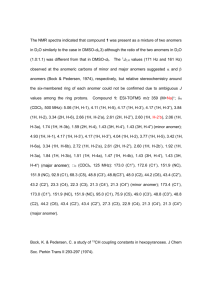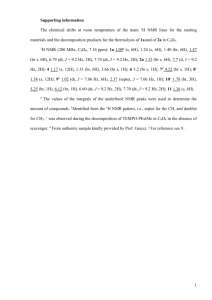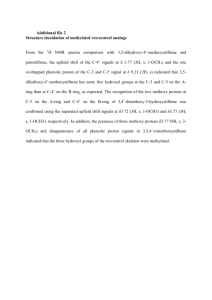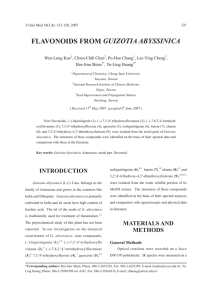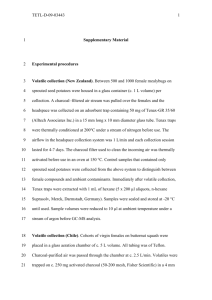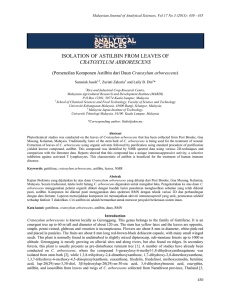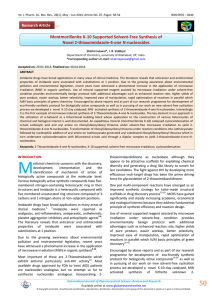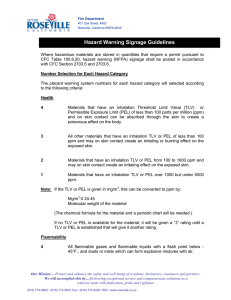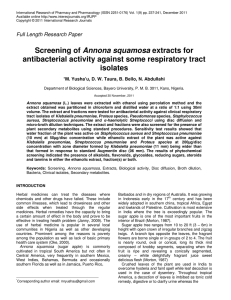Supplementary material to: A validated LC method for separation
advertisement
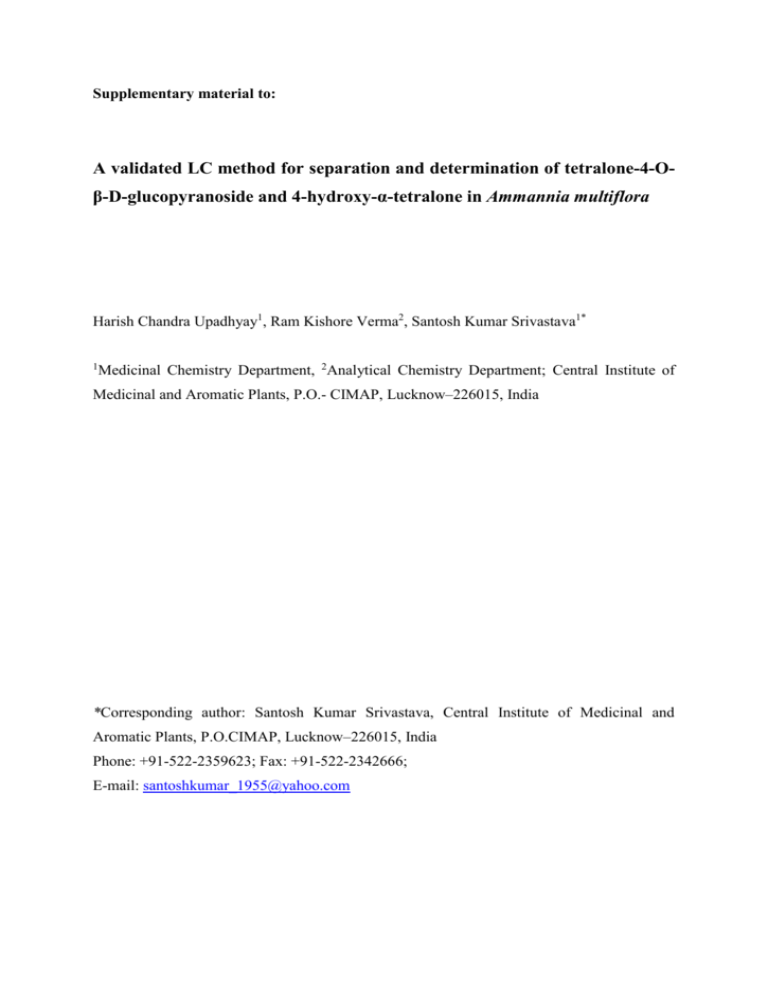
Supplementary material to: A validated LC method for separation and determination of tetralone-4-Oβ-D-glucopyranoside and 4-hydroxy-α-tetralone in Ammannia multiflora Harish Chandra Upadhyay1, Ram Kishore Verma2, Santosh Kumar Srivastava1* 1 Medicinal Chemistry Department, 2Analytical Chemistry Department; Central Institute of Medicinal and Aromatic Plants, P.O.- CIMAP, Lucknow–226015, India *Corresponding author: Santosh Kumar Srivastava, Central Institute of Medicinal and Aromatic Plants, P.O.CIMAP, Lucknow–226015, India Phone: +91-522-2359623; Fax: +91-522-2342666; E-mail: santoshkumar_1955@yahoo.com Extraction, isolation and characterization of marker compounds 1 and 2 The shade dried plant material was powdered by electrical grinder and was extracted and fractionated according to the following flow chart. Ammannia multiflora, powdered plant material (350g) Extracted with methanol overnight (3 x 1500 ml)) Marc Hexane extract*(15.5 g) MeOH Extract** (49.8 g) Extracted with hexane (3 x 400 ml) Aqueous extract Extracted with CHCl3 (3 x 400 ml) CHCl3 extract*(700 mg) Aqueous extract Extracted with n-BuOH (3 x 400 ml) n-BuOH extract** (13 g) *Washed Aqueous extract** (8 g) with water, dried over sodium sulphate and solvent removed under vacuum. **Solvent removed under vacuum The chloroform extract contained a major compound hence a portion (0.6 g) of this was purified over Silica gel column (60-120 mesh, 12 g). Gradient elution of the column was carried out with solvent of increasing polarity using hexane and chloroform in various proportions. A total 58 fractions of 50 mL each were collected and the TLC plates (silica gel 60F254) were examined under UV at 254 and 365 nm and by spraying of TLC plates with vanillin-sulphuric acid (1: 5, w/v) solution in ethanol followed by heating at 95oC for 5 min. Fractions 25-51 eluted with hexane: chloroform (2.5: 7.5 to 1: 9, v/v) afforded a pure compound, which was characterized as 4-hydroxy-α-tetralone (2, 412 mg). The butanol fraction was a very complex mixture; hence a portion (12 g) of this was subjected to Vacuum Liquid Chromatographic (VLC, 7.5 cm x 7.5 cm) separation over Silica gel H (125 g). Gradient elution of VLC column was carried out with solvents of increasing polarity viz. hexane, chloroform, methanol in various proportions. Fractions of 50 mL each were collected. A total of 426 fractions were collected and pooled on the basis of their TLC profile. Fractions 135-152 eluted with chloroform-methanol (93: 7, v/v), afforded the compound tetralone-4-O-β-D-glucopyranoside (1, 10.5 mg). Structures of the compound 1 and 2 were deduced on the basis of their 1D and 2D NMR, IR and ESI-MS spectroscopic data and comparison with the reported values [3, 4]. NMR and mass spectroscopic data of compounds 1 and 2 Tetralone-4-O-β-D-glucopyranoside (1): Amorphous powder, 1H NMR (300 MHz, C5D5N) δ 2.5 (1H, m, H-2), 2.9 (1H, m, H-2), 2.28 (1H, m, H-3), 2.39 (1H, m, H-3), 5.20 (1H, d, J = 6.2 Hz, H-4), 7.91 (1H, d, J = 7.5 Hz, H-5), 7.70 (1H, dd, J = 7.5, 1.5 Hz, H-6), 7.42 (1H, m, H-7), 8.05 (1H, dd, J = 7.5, 1.5 Hz, H-8); glucose; δ 4.51 (1H, d, J = 7.5 Hz, H-1’), 3.33 (1H, m, H-2’), 3.32 (1H, m, H-3’ and H-5’), 4.36 (1H, dd, J=11.7, 2.1 Hz, H-6’), 4.21 (1H, dd, J=11.7, 6.2 Hz, H-6’). 13C NMR (75 MHz, Pyridine, ) δ 197.2 (C-1), 35.0 (C-2), 31.9 (C-3), 75.1 (C-4) 127.0 (C-5), 133.4 (C-6), 129.1 (C-7), 128.6 (C-8), 132.0 (C-9), 143.4 (C-10); glucose; δ 104.0 (C-1’), 74.5 (C-2’), 78.4 (C-3’), 71.5 (C-4’), 78.3 (C-5’), 62.7 (C-6’). ESIMS m/z 327 [M+H]+ (calculated for C16H20O7, 326). 4-hydroxy-α-tetralone (2): Yellow viscous oil, 1H NMR (300 MHz, CDCl3) δ 2.44 (1H, m, H-2), 2.82 (1H, m, H-2), 2.36 (1H, m, H-3), 2.23 (1H, m, H-3), 4.67 (1H, d, J=6.2 Hz, H-4), 7.86 (1H, d, J=7.5 Hz, H-5), 7.47 (1H, dd, J=7.5, 1.5 Hz, H-6), 7.38 (1H, m, H-7), 7.27 (1H, dd, J=7.5, 1.5 Hz, H-8). C NMR (75 MHz, CDCl3) δ 197.8 (C-1), 35.1 (C-2), 32.0 (C-3), 13 67.6 (C-4), 127.0 (C-5), 134.0 (C-6), 127.4 (C-7), 127.6 (C-8), 131.0 (C-9), 145.5 (C-10). ). ESI-MS m/z 163 [M+H]+ (calculated for C10H10O2, 162)
